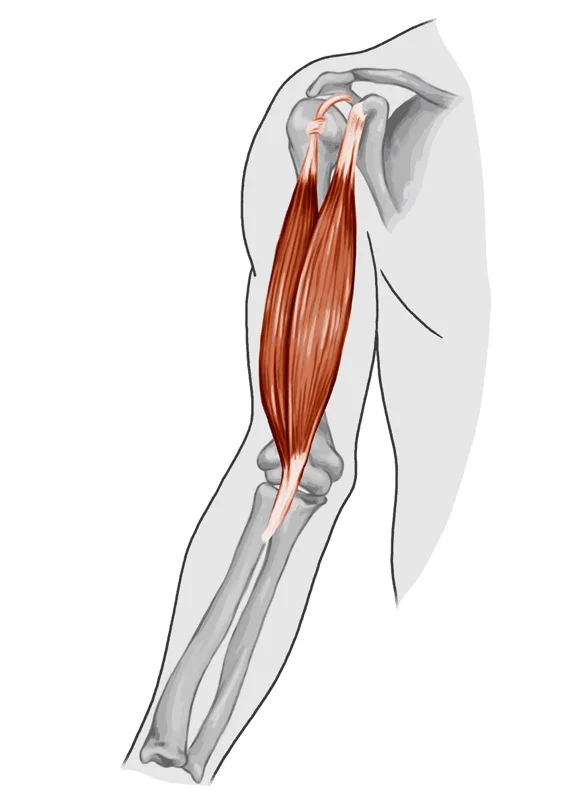Biceps Tendon Tear
Biceps tendon anatomy
The biceps is a muscle that runs along the front of your upper arm from your shoulder to the radius bone in your forearm. It is important for flexing the elbow and “supinating” the forearm (turning the palm towards the ceiling).
The biceps tendon can tear or rupture from its insertion site in the forearm when lifting a heavy object. While sometimes it may be due to underlying weakening of the tendon, or tendinitis, it often tears without any prior warning or symptoms.
Diagnosis
Patients oftentimes report a “pop” or “tearing” sensation in the front of their elbow associated with pain. There is frequently bruising along the front and inside of the elbow and arm. If the tendon retracts up the arm after tearing, there may be asymmetry between the two arms as one biceps muscle belly sits higher up the arm – the so-called “Popeye deformity”. Biceps tendons are usually palpable, but this is no longer the case after a tear. Other symptoms include pain and weakness when flexing the elbow or supinating (“rotating”) the forearm. An MRI will show the injury, but is not always necessary to make the diagnosis.
Non-Surgical Treatment
A completely torn biceps tendon cannot repair itself over time. Elbow flexion strength may be acceptable after a tear because there are other muscles still present that bend the elbow. However, when the end of the biceps tendon is no longer attached to bone, patients oftentimes have loss of endurance, fatigue during elbow flexion, and may experience cramping or discomfort when bending the elbow. Weakness with rotation (supination) tends to persist, which is noticed with activities such as turning a screwdriver or doorknob. While surgery is not absolutely required, it is oftentimes recommended.
Surgical Treatment
If surgery is to be done, it should be done soon following the injury within the first few weeks. If too much time has passed, a direct repair of the tendon back to the bone may no longer be possible.
I typically use a biceps tendon repair kit made by Arthex (shown below). This is an outpatient surgery that takes less than an hour. The arm is numbed by an anesthesiologist, and some sedation is given through an IV. No intubation or general anesthetic is required. A ~2 inch incision is made near the elbow, the torn tendon stump is located, and it is reinserted into the bone. The repair is held in place with both sutures and a small plastic screw. Dissolvable sutures are placed for the skin incision, and a splint is applied that holds the elbow bent at 90 degrees.
Schematic of biceps tendon repaired back to bone with suture and screw. Image from Arthrex. The avulsed tendon is reinserted into the bone, and held in place with both sutures and a small plastic screw.
Post-Surgery Rehabilitation
Weeks 0-2 (rest): After surgical repair, rehabilitation may vary slightly from case to case. Typically, a non-removable splint is placed in the OR that holds the elbow bent at 90 degrees for the first 2 weeks after surgery. This allows the tendon to start healing back to the bone.
Weeks 3-6 (motion): After ~2 weeks, elbow motion exercises are initiated. At this point, a removable elbow splint is used when sleeping and for activities. The splint is removed during the daytime for light use of the arm. During this phase, the goal is to restore normal motion of the elbow and arm. A therapist is sometimes used. While the elbow can be used between weeks 2 and 6, a common recommendation is to lift nothing heavier than a cup of coffee.
Week 6 and beyond (strength): At 6 weeks after the surgery, strengthening exercises are usually initiated. A therapist may be helpful. Early on, we start with gentle exercises (2-5 pound biceps curls) and progress from there.
3-4 months (full activities): The goal is full activities and normal use of the arm starting 3-4 months after surgery. It can take many months to return to pre-injury strength and endurance, but most people get there. Good rules of thumb include “listen to your body”, and “if it hurts, don’t do it”.
“My name is Wes, I had a full bicep tear back at the beginning of 2018. Dr. Schreiber was brilliant from beginning to end, from not making me get an unnecessary MRI, to how the surgery was going to go, to calming my wife down after surgery... He and the staff at Raleigh Ortho were top notch. I don’t recommend tearing your bicep but if you do Dr. Schreiber is the one to go to!”
“Dr. Schreiber did an outstanding job on biceps repair for me. He explained what to expect regarding surgery recovery and possible complications. I had some numbness in right forearm after surgery that he said would get better with time. It has been 3 months and it is exactly as he described. He is extremely professional in all interactions. I would strongly recommend anyone that needs this type of surgery to consider visiting Dr. Schreiber. Another extremely positive aspect is that he is always on time in all interactions that I have had. I find that amazing when I see that many MDs don’t value your time as much as their own. Thanks.”
Dr. Schreiber is a board certified orthopedic surgeon specializing in hand, wrist, and elbow conditions. Dr. Schreiber practices at the Raleigh Orthopaedic Clinic in Raleigh, North Carolina.
